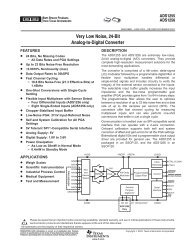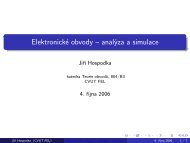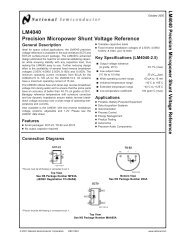LTC2410 24-Bit No Latency âΣTM ADC with Differential Input and ...
LTC2410 24-Bit No Latency âΣTM ADC with Differential Input and ...
LTC2410 24-Bit No Latency âΣTM ADC with Differential Input and ...
Create successful ePaper yourself
Turn your PDF publications into a flip-book with our unique Google optimized e-Paper software.
<strong>LTC<strong>24</strong>10</strong>TYPICAL APPLICATIO SUSample Driver for <strong>LTC<strong>24</strong>10</strong> SPI InterfaceThe <strong>LTC<strong>24</strong>10</strong> has a very simple serial interface that makesinterfacing to microprocessors <strong>and</strong> microcontrollers veryeasy.The listing in Figure 56 is a simple assembler routine forthe 68HC11 microcontroller. It uses PORT D, configuringit for SPI data transfer between the controller <strong>and</strong> the<strong>LTC<strong>24</strong>10</strong>. Figure 55 shows the simple 3-wire SPIconnection.The code begins by declaring variables <strong>and</strong> allocating fourmemory locations to store the 32-bit conversion result.This is followed by initializing PORT D’s SPI configuration.The program then enters the main sequence. It activatesthe <strong>LTC<strong>24</strong>10</strong>’s serial interface by setting the SS outputlow, sending a logic low to CS. It next waits in a loop fora logic low on the data line, signifying end-of-conversion.After the loop is satisfied, four SPI transfers are completed,retrieving the conversion. The main sequence endsby setting SS high. This places the <strong>LTC<strong>24</strong>10</strong>’s serialinterface in a high impedance state <strong>and</strong> initiates anotherconversion.The performance of the <strong>LTC<strong>24</strong>10</strong> can be verified using thedemonstration board DC291A, see Figure 57 for theschematic. This circuit uses the computer’s serial port togenerate power <strong>and</strong> the SPI digital signals necessary forstarting a conversion <strong>and</strong> reading the result. It includes aLabview application software program (see Figure 58)which graphically captures the conversion results. It canbe used to determine noise performance, stability <strong>and</strong><strong>with</strong> an external source, linearity. As exemplified in theschematic, the <strong>LTC<strong>24</strong>10</strong> is extremely easy to use. Thisdemonstration board <strong>and</strong> associated software is availableby contacting Linear Technology.<strong>LTC<strong>24</strong>10</strong>SCKSDOCS13121168HC11SCK (PD4)MISO (PD2)SS (PD5)<strong>24</strong>10 F55Figure 55. Connecting the <strong>LTC<strong>24</strong>10</strong> to a 68HC11 MCU Using the SPI Serial Interface43






